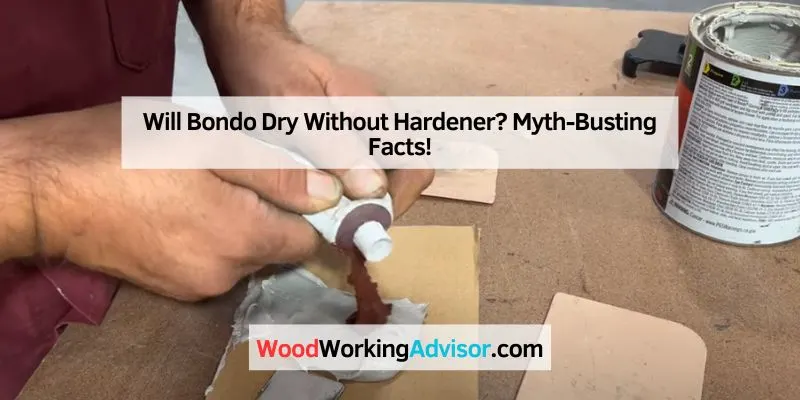Bondo will not dry properly without a hardener. The hardener is essential for the chemical reaction that allows Bondo to cure.
Bondo, a popular automotive body filler, is known for its durability and ease of use. Many DIY enthusiasts and professionals rely on it for repairs. Understanding how Bondo works is crucial for achieving the best results. This two-part system includes a base and a hardener.
The hardener activates the compound, allowing it to set and bond effectively. Without it, Bondo remains soft and unusable. This lack of curing leads to weak repairs and potential damage over time. Using Bondo correctly can significantly enhance the quality of your project, making it essential to follow the manufacturer’s instructions for optimal results.
Introduction To Bondo And Its Uses
Bondo is a popular body filler used in automotive repairs. It helps smooth out dents and scratches. This product is made from a resin and a hardener. The hardener is crucial for the drying process. Without it, Bondo may not set properly.
Common applications include repairing car panels, filling holes, and fixing furniture. It is easy to work with and can be sanded down. Many DIY enthusiasts and professionals use Bondo for quick fixes.
Understanding how Bondo works is essential. It is not just a filler; it bonds well with different surfaces. This makes it a versatile option for various repair projects.
The Role Of Hardener In Bondo
Bondo is a popular product used in auto repair and woodworking. Its chemical composition includes a resin and a hardener. The hardener is essential for the curing process. Without it, Bondo will not dry properly.
Using Bondo without hardener leads to soft and unusable material. This can result in poor adhesion and a weak bond. The hardener causes a chemical reaction that allows Bondo to harden. This process is what makes Bondo strong and durable.
| Component | Function |
|---|---|
| Resin | Forms the base of the product |
| Hardener | Initiates the curing process |
Common Myths About Bondo Drying
Bondo does not dry on its own. It requires a hardener to set properly. Without the hardener, Bondo remains soft and unusable. This is a common misconception.
Some people believe that the hardener is optional. In reality, the hardener is crucial for the drying process. Skipping it can lead to poor results. Bondo may not adhere well or may take a long time to cure.
Always mix Bondo with the correct amount of hardener. This ensures a strong and durable finish. Trusting these myths can cause frustration and wasted materials.

What Happens If You Skip The Hardener?
Skipping the hardener in Bondo can lead to serious issues. The immediate effects include a sticky texture that won’t cure properly. This makes it hard to sand or paint. Projects will take longer to finish.
In the long term, using Bondo without hardener can cause weakness in repairs. The surface may crack and peel over time. This can lead to more expensive repairs later. Always use hardener for the best results.
Real-life Experiments And Results
For the experiment setup, gather Bondo, a mixing tool, and a clean surface. Use one container for Bondo alone and another for Bondo with hardener. Prepare equal amounts for both containers.
Observations show that Bondo without hardener remains soft and never fully cures. The texture stays sticky and unusable. On the other hand, Bondo with hardener dries hard and can be sanded smoothly.
Results indicate that hardener is essential for proper drying. The difference is clear in both appearance and functionality. Always use the hardener for best results.
Expert Opinions On Bondo And Hardener
Many experts agree that Bondo needs a hardener to dry properly. Without it, the product remains soft and sticky. This can lead to poor repairs and durability issues. Always check the product instructions for the right hardener ratio.
For optimal use, follow these tips:
- Mix the hardener thoroughly with Bondo.
- Apply the mixture quickly to prevent premature drying.
- Work in a well-ventilated area for safety.
- Use the right tools to achieve a smooth finish.
- Store unused Bondo properly to maintain its quality.
How To Properly Mix And Apply Bondo
Mixing Bondo correctly is crucial for a strong bond. First, gather your materials: Bondo, hardener, mixing stick, and a clean surface. Use a small container for mixing. Squeeze out the right amount of Bondo and hardener. A common mix ratio is two parts Bondo to one part hardener.
Mix the two thoroughly until you see a uniform color. Apply Bondo with a putty knife. Spread it evenly over the surface you are repairing. Press down firmly to avoid air pockets. Allow it to cure for at least 30 minutes.
Common mistakes include using too much hardener or not mixing well. Avoid working in cold or humid conditions. Always wear gloves to protect your hands from the chemicals.

Faqs On Bondo And Hardener
Bondo needs a hardener to dry properly. Without it, Bondo will remain soft and won’t cure. This makes it unusable for repairs. Using Bondo without hardener leads to wasted time and materials.
Fixing improperly mixed Bondo can be tricky. Remove the uncured Bondo completely. Clean the area well before applying new Bondo. Make sure to mix the hardener and Bondo correctly this time. Follow the mixing ratio on the package. This ensures a strong bond and quick drying.
Frequently Asked Questions
Will Bondo Cure Without Hardener?
No, Bondo cannot cure without hardener. The hardener is essential for the chemical reaction that allows Bondo to set and harden properly. Without it, the product remains soft and unusable. Always mix Bondo with the recommended amount of hardener for optimal results.
How Long Does Bondo Take To Dry?
Bondo typically takes about 20 to 30 minutes to dry. However, drying time can vary based on temperature and humidity. For best results, allow it to cure fully before sanding or painting. Always check the manufacturer’s instructions for specific guidelines.
Can You Use Bondo On Plastic?
Yes, Bondo can be used on plastic surfaces. However, you must use a plastic-specific Bondo or an appropriate adhesive for plastic. Proper surface preparation is crucial to ensure good adhesion. Clean and sand the area before applying the product for optimal results.
What Happens If Bondo Is Not Mixed Properly?
If Bondo is not mixed properly, it may not cure effectively. This can lead to a weak bond or a soft, tacky surface. Always follow the mixing instructions carefully for the best outcome. A proper mix ensures durability and longevity of the repair.
Conclusion
Bondo without hardener won’t cure properly, leading to weak repairs. Proper mixing is essential for achieving strength and durability. Always follow the manufacturer’s instructions for best results. For reliable repairs, don’t skip the hardener. This ensures your projects stand the test of time and maintain their integrity.
Choose wisely for lasting results.

